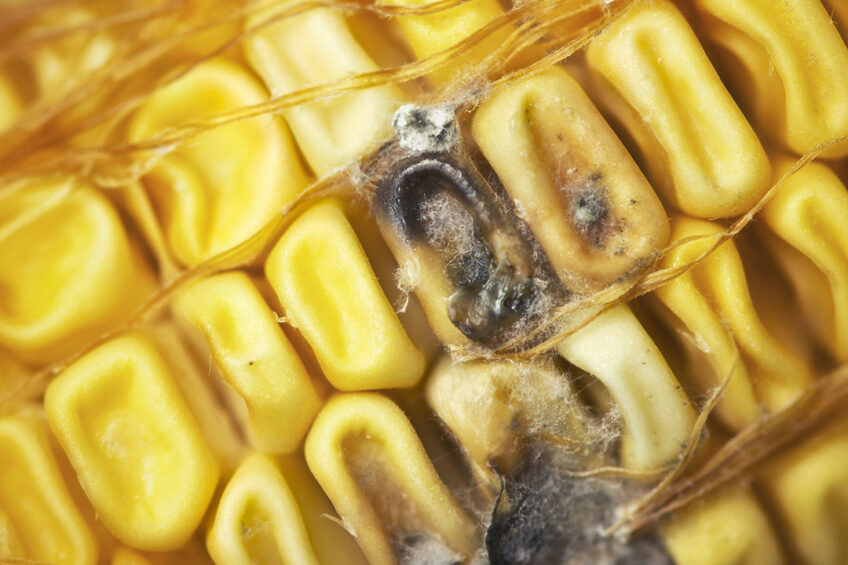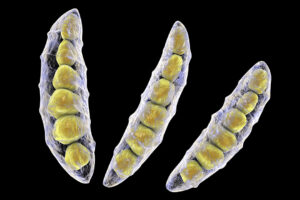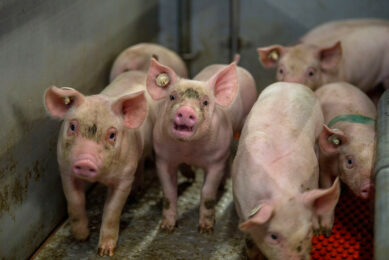Mycotoxins in pigs: The state of DON research

Deoxynivalenol – better known by its abbreviation “DON” – continues to keep researchers busy. As new modes of action of this mycotoxin are being discovered, the question remains: how can we mitigate its negative effects on pigs? This overview provides a summary.
DON is the most common mycotoxin in pig feed. It is found in corn and cereals that have suffered infections of Fusarium fungus. There are limits to the amount of DON allowed in pig feed because even small amounts affect pig performance. There has therefore been a great deal of research into how to measure and mitigate the effects of DON and other mycotoxins such as aflatoxin and zearalenone (ZEN). A few hundred mycotoxins with widely different chemical structures have been identified to date.
Latest findings – effects on pig and piglet health
In a 2021 review of research on DON and other mycotoxins, Dr Sung Woo Kim at North Carolina State University and his colleagues concluded that the effects of these compounds on pigs include immune modulation, disruption of intestinal barrier function and cell death. “In our paper published in May 2021, we found that DON consumption by pigs altered [brain biochemistry] and resulted in increased passive and quiescent behaviour,” says Kim. DON was also shown to damage the study pigs’ intestinal tracts due to “a direct toxic effect”.
Performance of piglets
A recent study on suckling piglets found that when DON, ZEN and their derivatives are transferred from the sow diet to the piglets through colostrum and milk, the performance of the piglets was not affected, but an inflammatory process was taking place in their bodies.
Kim notes that based on his research with colleagues, preparing young pigs with good intestinal health to handle DON challenge is currently an effective way to cope with DON.
Latest findings – detoxification of DON
Regarding the feed itself, many strategies and feed additives (detoxifiers) have been examined in terms of their ability to reduce or mitigate the effects of DON and other mycotoxins. In a new review published in January 2022, researchers at Huazhong Agricultural University in China conclude that the various strategies each have advantages and disadvantages.
Strategies include:
- Physical detoxification (separation, washing, heating, irradiation and adsorption)
- Chemical treatments (bases and oxidising agents)
- Biological detoxification methods (micro-organisms and enzymes)
- Nutritional regulation strategies (antioxidants such as vitamin E, selenium and curcumin) (see also Table 1).
However, the researchers note that many of the physical and chemical decontamination strategies that have been explored are limited in terms of binding efficiency, biosafety or cost-effectiveness.
That view is shared by Professor Piotr Jedziniak of the Department of Pharmacology and Toxicology at the National Veterinary Research Institute in Poland. “There are no effective adsorbents for DON because of its chemical properties,” he says. “There is research into various biological agents that could degrade mycotoxins such as micro-organisms and enzymes, but in my opinion, the capability of biological additives is, so far, not sufficient. They activate in the stomach, and there are very few experiments showing good effectiveness. Part of the reason there are few experiments is that animal testing is very costly.”
Adding enzymes and adsorbents
Dr Kim and his colleagues have observed in their studies that partial protection of the pig intestine is achievable through adding enzymes and adsorbents to the diet. But, Dr Kim says, “I was not sure if the protective effect was from the enzyme activity or adsorbents.” Like Prof Jedziniak, Dr Kim notes that while DON has been shown to be deactivated by enzymes in lab tests, proof of this actually occurring in the pig intestine is limited.
The frequent co-contamination with mycotoxins in feedstuffs and feeds intended for pig consumption makes mycotoxin-detoxifying agents targeting multiple mycotoxins preferable
Dr Sung Woo Kim, North Carolina State University
Organic and inorganic sources
In their 2021 review, Dr Kim and his colleagues also note that products currently on the market can combine organic and inorganic sources to enhance their adsorbability, immune stimulation or detoxification ability – but that “the frequent co-contamination with mycotoxins in feedstuffs and feeds intended for pig consumption makes mycotoxin-detoxifying agents targeting multiple mycotoxins preferable”.
Feeding higher concentrations of nutrients and antioxidants
A recent study by researchers at the Prairie Swine Centre in Saskatchewan, Canada, also points to the potential of mitigating the effects of DON by feeding higher concentrations of nutrients and antioxidants to promote overall health (and counter the impact of lower feed intake that was seen in the study.)
Modelling research was recently published from French scientists that focuses on the feed intake response of growing pigs to diets contaminated with mycotoxins. They found that pig age and previous exposure to DON have a modest effect on “resilience capacity” (capacity to deal with toxins in the feed). The researchers propose that the degree of response to mycotoxin-contaminated feed (aversion or less aversion to eating it) can be characterised in terms of “resistance and resilience” traits, and that “these traits can be a potential source for genetic selection to breed animals for enhanced robustness”.
The latest findings – actual DON exposure
While feed intake and feed analysis have long been used to determine how much DON exposure is happening, the amount of biomarkers found in blood plasma can provide more insight. That is explained in a review by Prof Jedziniak and his colleague Dr Agnieszka Tkaczyk, published in August 2021, called “Mycotoxin biomarkers in pigs – current state of knowledge and analytics”.

First, Prof Jedziniak and Dr Tkaczyk note that among the mycotoxins such as DON that are excreted when Fusarium fungus infects corn plant, some of the DON is metabolised by the plant into other forms. “Many so-called ‘modified mycotoxins’ have been identified so far and while they are not all more toxic than DON itself, the toxicity level of the toxic ones is yet to be determined,” says Prof Jedziniak.
“They may consequently contribute to higher toxicity, and this has already been shown for 3- and 15-acetyl-deoxynivalenol (3- and 15-Ac-DON) and deoxynivalenol-3-glucoside (DON-3-Glc) in pigs and broiler chickens.”
Prof Jedziniak adds that although there are no requirements at this point to measure levels of these modified mycotoxins in feed, the European Food Scientific Agency has recently recommended they be monitored. Prof Jedziniak says these modified versions “are more and more detected in feed analysed for mycotoxins”.
That fact is not accounted for when pig toxin exposure is estimated using the traditional framework of feed intake effects and traditional feed analysis. Prof Jedziniak and Dr Tkaczyk also note that toxins in feed can have a “highly inhomogeneous distribution”, leading to irrelevant traditional feed analysis results.
“Another problem is the fact that feed analysis and feed intake measurement do not provide data about the individual exposure because of ‘synergies’ among animals – differences in food consumption and absorption, metabolism and excretion processes,” Prof Jedziniak explains. “Due to all these difficulties, the exposure assessment of animals might include a much broader analysis of toxin contamination in the feed along with an analysis of the amount of ‘biomarkers’ in blood plasma to evaluate individual toxin exposure.”
Biomarker analysis
While biomarker analysis is expensive because it involves mass spectrometry, Prof Jedziniak says that in using it, the pig industry can gain many benefits in terms of mitigating DON. Those benefits range from much more accurate insight into the effects of recent, past and cumulative mycotoxin exposure to much more effective testing of various detoxifiers.
Looking forward, Prof Jedziniak says, “It’s impossible to produce corn without DON and other toxins, and there is no one solution that can be applied.
“We have to progress with breeding Fusarium-resistant corn, maybe pig breeding too, developing crop fungicides and researching various detoxifiers. New methods such as biomarker measurement can provide a great deal more insight compared to traditional tools. We need to continue to research secondary Fusarium toxins and biological detoxifiers such as probiotics like Lactobacillus. They are destroyed during the high-temperature feed pellet manufacturing process, but perhaps they can be added to the diet in the water. It is a very promising area to explore, but only some probiotics are currently available for animal use.”











